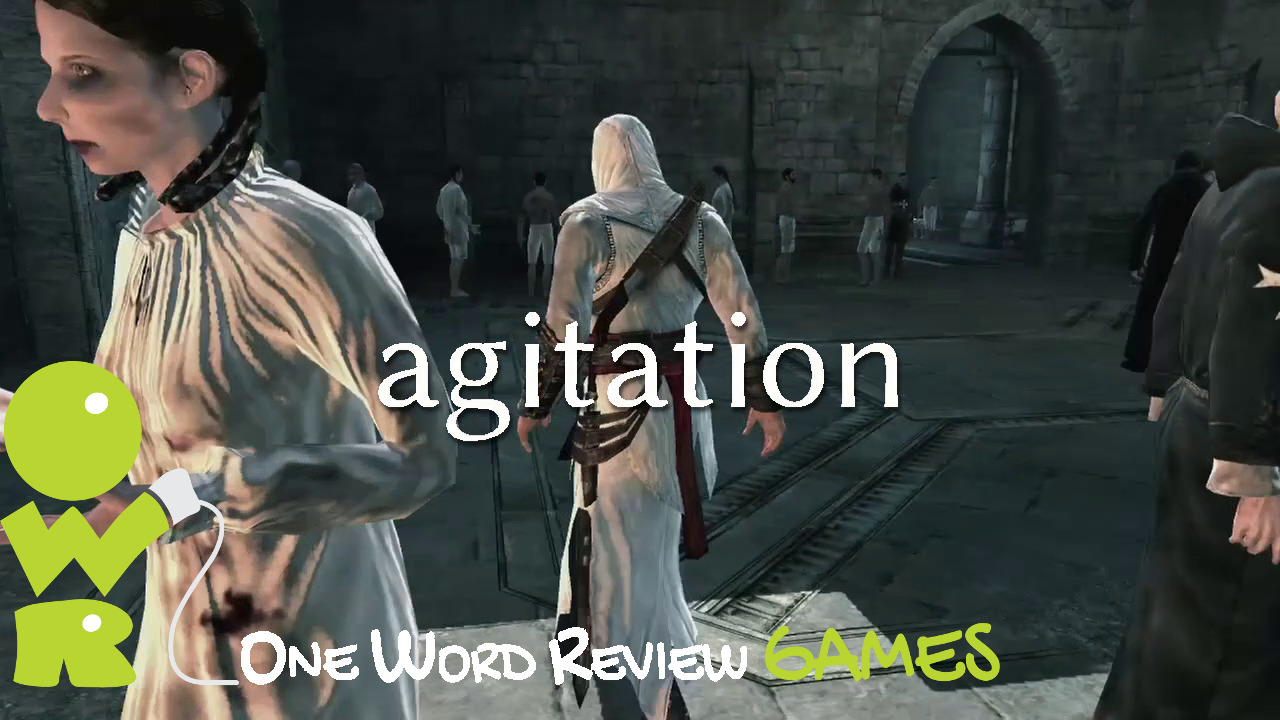
Tag: One Word Review

One Word Review – Assassin’s Creed

agitation
Assassin’s Creed is and was a huge success. It was one of two games at the time that everybody I knew owned; that and Call of Duty: Modern Warfare. The game caused a restlessness amongst video game players. The story and the movement in the game was something new in a landscape of bland shooters that were trying to top one another but, in reality, just blended into the background with each other.
Ubisoft wanted a discussion to arise with players around the world because of this game. The September 11th attacks were still fresh in people’s minds. The wars in Iraq and Afghanistan were mired in the mud (which is especially difficult to do in arid regions). Islamophobia was growing exponentially around the world and Ubisoft based their story in the fertile crescent. Moreover, Assassin’s Creed is the story of the battle between Muslim Assassins and Christian Templars. This led Ubisoft to add a disclaimer to the beginning of the game,
Inspired by historical events and characters. This work of fiction was designed, developed, and produced by a multicultural team of various religious faiths and beliefs.
Assassin’s Creed (AC) landed at a perfect time for Ubisoft. People wanted to play something different. Many people around the world wanted a story that turned the narrative around on their Muslim brothers who, for the last 5 years, had seen all of their accomplishments in history expunged and replaced with the image of terrorist and nothing else. Ubisoft wanted to shake up that image of Islam and show the rich history, contributions, and coolness of Islam vs. Western Christianity. They knew that this game was going to push some buttons and they were fine with that, up to a point.
The movement in AC was satisfying. Running across the tops of the buildings in places like Acre and Damascus was a lot of fun. The architecture changed between locals based on which religion controlled the city – some had more churches and some had more mosques. They all had a mixture of religions though, which is part of the message that Ubisoft was trying to impart on people during this time. It wasn’t shocking, at the time the game is set in, to have these people living in the same places and respecting the beliefs of their neighbors. (Why is it shocking to us now?) Sure the leaders were trying to end the other side but the player never sees any of the people in the cities being nasty to each other just based on each others’ beliefs.
Climbing those mammoth buildings of religious significance stirred up a torrent of feelings within me. I loved finding the perfect footholds on those churches and minarets. Of course as I progressed in the game it got easier to recognize the holds, the illusion was gone, but that never stopped it from being fun. The exorcise in starting at the bottom, finding my way to the apex, and then free falling down into a fluffy stack of hay was meditative for me. For a thirty to forty hour game, it is strange that this one mechanic was the happiest part for me.
The story, which I should have loved, was good but it didn’t take me on a voyage like I had wanted. I found the most intriguing moments were those spent in present day, outside of the Animus, the sleep inducing cognitive time machine that transports your character’s memories into his ancestors. The main plot between the Templars and the Assassin’s was interesting but the past, which is the meat of the game, isn’t as intriguing as the few bits of story outside the Animus concerning how these two groups continue to run things to this day. And for a story that largely takes place in the past, that seems like a missed opportunity.
The boss battles have some good story elements that give the player the pathos to want to kill thousands of these nameless NPCs but the final battle between Altair and Al Mualim for the Apple of Eden story wise was obvious. Of course the man who had been mentoring Altair the entire game would turn; Oedipus complex and all that. Also, the combat was terrible.
The combat is a problem throughout the game. From simple fights in the streets with thugs, to the boss battles that progress the story, and the inevitable fights that happen with the bosses’ minions as Altair runs back to one of his safe houses after slaying said bosses. The combat has a fluidity which matches the movement in the game but it just isn’t fun.
It makes sense that an assassin shouldn’t be fighting in large groups. It also makes sense that he should be finding hiding spots to get away from the combat. But, the designers made the combat and they definitely wanted the player to spend time with their combat system instead of running from everything. This is evident during the final chapter of the game when you are tasked with killing the grandmaster of the Templars and you must fight through an army of Templars to finally kill him. I almost quit the game during this final battle because I was so aggravated by the combat system.
I was moved by the environments and the traversal across the world. I enjoyed the prospect of the story but I wasn’t excited by much of it besides the parts out of the Animus. AC came around at a perfect time and the people who played it found the seed of what the developers wanted them to see and this gave them a franchise. I worry that the franchise has become too focused on what it did right, which was mobility around the world of AC, and it should have focused on the problems like making the in Animus story better and the combat more engaging.
The development of this game shook up the established order of making games in many ways. It was brought to life by people who didn’t want to tell the same boring space marine type action story. The game’s traversal system was groundbreaking and the player learned to love moving around the world. The combat fermented some heavy emotions that almost beat me into submission. Parts of the story though caused a pandemonium amoungst players who wanted to see where Ubisoft could take this story while using other times and places, especially in present day which I am most excited to learn more about. I hope Ubisoft keeps shaking things up with this series because they definitely helped change the narrative for many people around the world with respect to current events.
One Word Review – Bioshock

dichotomy
As the player wanders the sea soaked halls of Bioshock’s Rapture it is hard not to be awed by the beautifully produced art deco interiors and the mammoth bronzed statues of the patron of this utopian society, Andrew Ryan. The art and style of Rapture is juxtaposed with the sickness and eventual death of the underwater city itself. The 1960’s style advertisements for tobacco and alcohol somehow fit nicely along with graven images of hands pulling off the chains that Ryan believes the “parasites” above ground have placed on free enterprise and, in turn, humanity. This is an example of how Bioshock uses the city of Rapture as a character to impart the story of how this Objectivist society went from utopia to tribulation in a few short years.
Andrew Ryan created his sacred city to stand in contrast to what he believes went wrong with American capitalism. He believes that American society’s move towards socialism, through Roosevelt’s New Deal, and it’s predilection for ethical behavior in business have lead to a point where the producers, inventors, and businessmen have been enslaved in the chains of “socialism” and America’s capitalistic origins have been watered down so much that Ryan’s only option was to “create” Rapture.
As you explore Rapture you see how this Ayn Rand style Objectivist society that Ryan built up has failed; the plastic surgeons who didn’t think a nose job was quite enough, the artist who uses those around him (physically or mentally) to produce his art which is of questionable quality, and the grifter who wanted to take his piece of the pie by any means necessary. At every point in the story we are told to believe that Andrew Ryan’s ingenuity, money, and vision built the city of Rapture, but through audio-logs, the predominant storytelling mechanism, we find hints that there are citizens who realize that they are the ones who built the city; they are the ones who maintain this man’s vision of utopia. We find out later what happens to the poor in Rapture to keep this notion that an Objectivist utopian society can be sustained by the rich, without help from the poor.